Facts About Mouna
Mouna, sometimes called Mona, is a delectable traditional sweet bread with origins in Algerian Jewish and Sephardi cultures. It bears resemblance to challah, kubaneh, or brioche and is especially savored during Jewish holidays such as Mimouna and Shabbat. Its popularity extends beyond Algeria to France and Israel as well. What distinguishes Mouna is its sweet, rich flavor, derived from ingredients like oil, eggs, and often anise, sesame, or citrus.
The name "Mouna" is derived from the Jewish holiday Mimouna, celebrated by Maghrebi Jews to mark the end of Passover with a feast laden with sweets and baked delicacies. The term likely originates from the Hebrew word "emunah" meaning faith. Mouna holds a special place in Algerian Jewish cuisine and is equally cherished in Moroccan, Tunisian, French, and Israeli Jewish communities due to the widespread presence of Maghrebi Jews in these regions.
This sweet bread is typically served for Shabbat and other festive occasions, including Mimouna and the Yom Kippur break fast. It's a delicate treat, sometimes even filled with jam. Making Mouna involves preparing a rich dough with flour, eggs, cooking oil, water, sugar, salt, anise seeds, and citrus zest or juice. The dough is kneaded, allowed to rise, shaped into balls, and then joined together in a pan. Before baking, it's coated with an egg wash and sprinkled with powdered sugar, sesame, or anise seeds. The result is a beautiful bread that resembles Yemenite kubaneh or American monkey bread, but with its distinct, sweet twist.

 Libya
Libya